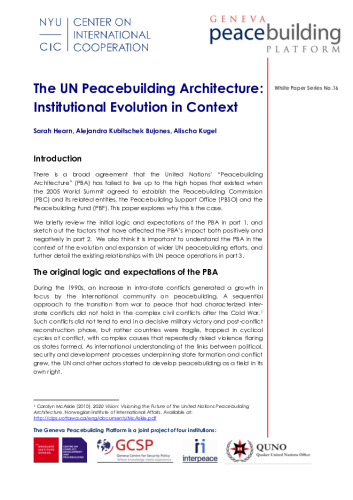There is a broad agreement that the United Nations’ “Peacebuilding Architecture” (PBA) has failed to live up to the high hopes that existed when the 2005 World Summit agreed to establish the Peacebuilding Commission (PBC) and its related entities, the Peacebuilding Support Office (PBSO) and the Peacebuilding Fund (PBF). This paper explores why this is the case.
In this paper, the authors briefly review the initial logic and expectations of the PBA in part 1, and sketch out the factors that have affected the PBA’s impact both positively and negatively in part 2. It is important to understand the PBA in the context of the evolution and expansion of wider UN peacebuilding efforts, and further detail the existing relationships with UN peace operations in part 3.
Read the full brief: The UN Peacebuilding Architecture: Institutional Evolution in Context
About the White Paper on Peacebuilding: The White Paper on Peacebuilding is a collaborative, multi-stakeholder process initiated by the Geneva Peacebuilding Platform and supported by the Swiss Federal Department of Foreign Affairs. It has the objective to situate UN peacebuilding within the broader peacebuilding universe and to articulate visions for the future for building peace in violent and fragile contexts. The White Paper places peacebuilding within the changing characteristics of armed violence and security, and within the practical evidence of engagements in peacebuilding contexts emanating from a diversity of fields. Ensuring a better relationship between UN peacebuilding and the broader peacebuilding field is a complementary effort to the existing work surrounding the 10-year review of the UN peacebuilding architecture and an effort to take stock of the nature and evolution of the broader peacebuilding universe.
This paper was published as a collaboration between the NYU Center on International Cooperation and the Geneva Peacebuilding Platform.


